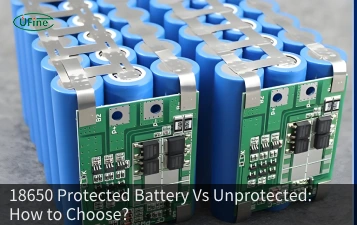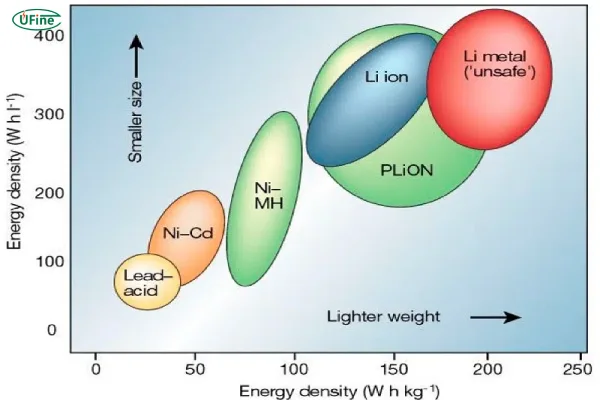
- Part 1. What is energy density in batteries?
- Part 2. Why energy density matters in modern technology
- Part 3. Overview of common battery chemistries and their energy densities
- Part 4. What is the highest energy density battery today?
- Part 5. How does energy density affect battery performance?
- Part 6. Is the higher the battery energy density, the better?
- Part 7. Lithium-air batteries: theoretical champion
- Part 8. Solid-state batteries: practical contender
- Part 9. Lithium-sulfur batteries: next-gen potential
- Part 10. Final thoughts
- Part 11. FAQs
In an age driven by mobile devices, electric vehicles, and renewable energy, the demand for high-performance batteries is higher than ever. One of the most critical metrics in determining a battery’s capability is energy density—a factor that directly affects how long a battery lasts and how much energy it can store in a given size or weight. But among the various battery technologies available today, what is the highest energy density battery? Let’s explore.
Part 1. What is energy density in batteries?
Energy density is a measurement of how much energy a battery can store relative to its weight or volume. It’s usually expressed in two ways:
- Gravimetric energy density: Measured in watt-hours per kilogram (Wh/kg).
- Volumetric energy density: Measured in watt-hours per liter (Wh/L).
A battery with high gravimetric energy density is lighter for the same capacity, which is vital for electric vehicles and drones. High volumetric energy density, on the other hand, is important in compact electronics where space is limited.
Part 2. Why energy density matters in modern technology
Modern technology—from smartphones and laptops to electric cars and space applications—relies heavily on battery performance. Devices demand longer runtimes without an increase in size or weight.
High energy density allows:
- Electric vehicles (EVs) to travel longer distances on a single charge.
- Smartphones and laptops to become slimmer without sacrificing battery life.
- Drones and aerospace vehicles to fly longer and carry more payload.
- Renewable energy systems to store more power with smaller storage units.
In short, better energy density means more energy, less bulk.
Part 3. Overview of common battery chemistries and their energy densities
Let’s compare some of the most common battery chemistries available today:
| Battery Type | Gravimetric Energy Density (Wh/kg) | Volumetric Energy Density (Wh/L) |
|---|---|---|
| Lead-acid | 30–50 | 60–110 |
| Nickel-Metal Hydride (NiMH) | 60–120 | 140–300 |
| Lithium-ion (NMC/NCA) | 150–250 | 250–730 |
| Lithium Iron Phosphate (LFP) | 90–160 | 220–400 |
| Solid-State | 250–400 (potential) | 500–1,000+ (potential) |
| Lithium-Sulfur | Up to 500 (theoretical) | ~400–600 (theoretical) |
| Lithium-Air | Up to 1,200 (theoretical) | Over 1,000 (theoretical) |
Note: Theoretical energy densities represent lab potential, not yet achieved in commercial batteries.
Part 4. What is the highest energy density battery today?
As of now, Lithium-Air (Li-air) batteries hold the theoretical crown with gravimetric energy densities as high as 1,200 Wh/kg—comparable to gasoline. However, these batteries are still largely experimental and face severe technical challenges that prevent commercial use.
In terms of practical, near-commercial technologies, solid-state lithium-metal batteries currently lead the pack. Companies like QuantumScape, Toyota, and Solid Power have reported prototype cells with energy densities approaching 400 Wh/kg and beyond.
For mainstream applications, Lithium Nickel Cobalt Aluminum Oxide (NCA) and Lithium Nickel Manganese Cobalt Oxide (NMC) are the top performers, used by Tesla and other EV manufacturers. They typically deliver 250–300 Wh/kg, offering a reliable balance of energy density, safety, and lifespan.
The Ultimate Guide to Lithium Air Battery
Part 5. How does energy density affect battery performance?
Energy density directly influences how long a battery can run before needing a recharge. Here’s how it impacts key performance metrics:
1. Run Time
Higher energy density batteries store more energy in the same size, giving devices longer operating times.
2. Weight and Portability
Lighter batteries with high energy density are ideal for mobile electronics, drones, and EVs.
3. Form Factor
Devices can be made thinner and more compact without sacrificing performance.
4. Range in EVs
Energy-dense batteries enable electric vehicles to drive farther on a single charge—critical for consumer adoption.
5. Payload Efficiency
In aviation and aerospace, higher energy density allows for heavier payloads or extended flight durations.
However, it’s important to note that energy density isn’t the only factor. Charge time, safety, cost, and cycle life also determine real-world battery performance.
Part 6. Is the higher the battery energy density, the better?
While high energy density is desirable, more isn’t always better. Trade-offs come into play, and they are crucial:
1. Safety Risks
Batteries with higher energy densities often operate at more volatile states, increasing the risk of thermal runaway (fires or explosions).
2. Reduced Lifespan
Some high-density batteries degrade faster over charge cycles. Lithium-sulfur batteries, for example, suffer from poor cycle stability.
3. High Cost
Advanced materials and manufacturing techniques can significantly increase production costs.
4. Lower Power Density
Energy density refers to total stored energy, while power density relates to how quickly it can be discharged. Some high-energy-density batteries can’t deliver bursts of power efficiently.
5. Scalability and Manufacturing Challenges
New technologies may work in the lab but be difficult or costly to scale.
Bottom line: The “best” battery balances energy density with safety, cycle life, manufacturability, and cost-efficiency.
Part 7. Lithium-air batteries: theoretical champion
Lithium-air batteries use oxygen from the air as a reactant, which drastically reduces the weight of the cell, allowing for exceptionally high energy densities. In theory, Li-air batteries can reach 1,200 Wh/kg, over ten times that of current lithium-ion batteries.
Challenges:
- Unstable electrolyte reactions.
- Limited recharge cycles.
- Susceptibility to moisture and CO₂.
- Poor round-trip efficiency.
Though promising, lithium-air batteries are unlikely to become mainstream in the near future due to these unresolved challenges.
Part 8. Solid-state batteries: practical contender
Solid-state batteries replace the flammable liquid electrolyte with a solid one, improving both safety and energy density.
Advantages:
- Up to 400–500 Wh/kg potential.
- Enhanced thermal stability (reduced fire risk).
- Longer cycle life.
- Smaller form factors.
Companies like Toyota, QuantumScape, and Samsung are making significant progress. Toyota has announced plans to release solid-state EVs in the coming years. If commercialized effectively, solid-state batteries could revolutionize multiple industries.
Part 9. Lithium-sulfur batteries: next-gen potential
Lithium-sulfur (Li-S) batteries use sulfur as the cathode and lithium as the anode. They have a theoretical energy density of around 500 Wh/kg, more than double that of current lithium-ion cells.
Advantages:
- Low material cost (sulfur is abundant).
- High energy density.
- Environmentally friendly components.
Limitations:
- Poor cycle life due to sulfur dissolution and volume expansion.
- Low conductivity.
- Rapid capacity loss.
Despite these issues, several research labs and startups are actively working on improving Li-S technology.
Part 10. Final thoughts
The quest for the highest energy density battery is far from over. While lithium-air holds the theoretical title, solid-state lithium-metal batteries currently lead in practical applications. Lithium-sulfur and other next-gen chemistries offer hope, but challenges remain.
As technology advances, the energy density of batteries will continue to rise—unlocking new possibilities in transportation, electronics, space exploration, and beyond. However, the journey involves balancing energy with safety, cost, and durability.
Part 11. FAQs
1. What battery has the highest energy density today?
Currently, solid-state lithium-metal batteries offer the highest practical energy densities, around 400–500 Wh/kg. Lithium-air batteries have the highest theoretical energy density, but they’re still experimental.
2. Is lithium-sulfur better than lithium-ion?
Lithium-sulfur has a higher theoretical energy density (~500 Wh/kg) and uses cheaper, eco-friendly materials. However, it suffers from short cycle life and stability issues. Lithium-ion remains the industry standard due to its maturity and reliability.
3. Why do electric vehicles need high energy density batteries?
High energy density allows EVs to travel farther per charge without increasing battery size or weight. This improves performance and reduces range anxiety.
4. Are solid-state batteries safe?
Yes, solid-state batteries are generally safer than traditional lithium-ion batteries. They use non-flammable solid electrolytes, which significantly reduce the risk of fires and explosions.
5. What limits the energy density of batteries?
Key limiting factors include:
- Material properties (electrode/electrolyte choices).
- Thermal and chemical stability.
- Physical constraints like swelling, dendrite formation, and safety concerns.
Related Tags:
More Articles

18650 Protected Battery VS Unprotected: Which One Is Better?
Discover the differences between protected and unprotected 18650 batteries. Learn which type offers better safety and performance for your device.
How to Choose the 18650 Vape Battery?
How to choose the 18650 vape battery? Deciphering capacity, discharge rates, and compatibility. This guide equips users with insights for informed decisions.
18650 Battery 2600mAh: Specifications, Recommend, Applications
18650 batteries: rechargeable lithium-ion used in electronics. 2600mAh variant known for longevity, high energy density, reliable performance.
Top 10 11.1V LiPo 3S Battery Models in 2025
Explore our curated list of the 10 best 11.1V 3S LiPo batteries. Find reliable options that enhance your devices' performance and longevity.
How Long Do Rechargeable Vape Batteries Last?
Learn about the lifespan of rechargeable vape batteries, factors that impact their longevity, and tips to keep them performing at their best.



